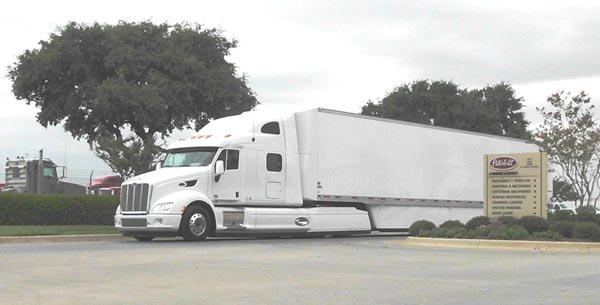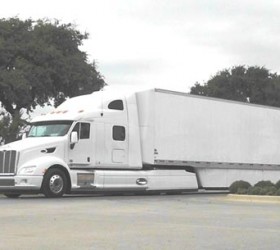Cummins Inc. and Peterbilt Motors Company, a division of PACCAR has released test results today showing their demonstration tractor-trailer achieved a 54 percent increase in fuel economy, averaging nearly 10 miles per gallon (mpg) under real world driving conditions.
The “SuperTruck” developed by the two companies features a higher-efficiency engine and an aerodynamic tractor-trailer that significantly reduces drag. The truck also includes a system that converts exhaust heat into power delivered to the crankshaft, electronic controls that use route information to optimize fuel use, tires with lower rolling resistence and lighter-weight material throughout.
The Class 8 Peterbilt 587 powered by a Cummins ISX15 engine averaged 9.9 mpg during testing last fall on U.S. Route 287 between Fort Worth and Vernon, Texas. The testing was conducted over 11 runs meeting SAE International test standards along a 312-mile route. The tractor-trailer had a combined gross weight of 65,000 lbs.
Todays long-haul trucks typically achieve between 5.5 and 6.5 mpg. The 54 percent increase in fuel economy would save about $25,000 annually based on todays diesel fuel prices for a long-haul truck traveling 120,000 miles per year. It would also translate into a 35 percent reduction in annual greenhouse gases per truck.
The potential savings in fuel and greenhouse gases are enormous, with about 2 million registered tractor-trailers on U.S. roads today, according to The American Trucking Association.
In addition to the fuel economy improvements, the truck also demonstrated a 61 percent improvement in freight efficiency during testing compared to a baseline truck driving the same route. That significantly exceeded the 50 percent SuperTruck program goal set by the U.S. Department of Energy. Freight efficiency is an important metric in the transportation industry that is based on payload weight and fuel efficiency expressed in ton-miles per gallon.
Many of the technologies we are testing on the engine and truck will be integral parts of the trucks of tomorrow, said David Koeberlein, Principal Investigator for the SuperTruck program at Cummins. We are focused on developing innovations that meet and exceed the needs of our customers, while helping to create a cleaner, healthier and safer environment.
Cummins personnel have been focused on the engine and its integration with the powertrain. They have been working with several other companies and research institutions to develop numerous changes in the combustion system as well as advances to reduce internal friction and so-called parasitic power excess power the engine needs to run such things as lube and coolant pumps and air compressors.
In addition to the trucks exterior, Peterbilt and its partners have been working on improvements in the drivetrain, the idle management system, weight reduction and vehicle climate control. Eatons advanced transmission facilitates further engine downspeeding for additional fuel economy benefits.
Aerodynamics has been a significant contributor to the efficiency gains, said Scott Newhouse, Senior Assistant Chief Engineer of Product Development at Peterbilt. We are very pleased with what our team has been able to accomplish using a comprehensive tractor-trailer approach.
Cummins is a prime contractor leading one of four vertical teams under the Department of Energys SuperTruck project. SuperTruck is one of several initiatives under the 21st Century Truck Partnership, which is a public-private partnership founded to further stimulate innovation in the trucking industry through the sponsoring government agencies, companies, national laboratories and universities.
Cummins, Peterbilt and their program partners will have invested $38.8 million in private funds over the four-year life of their SuperTruck program, which started in 2010, with critical support coming through awarded matching grants from the Department of Energys Vehicle Technologies Program.
Testing will continue in 2013 on a new Peterbilt 579 that Cummins and Peterbilt are confident will take what has been achieved so far to even higher levels. The testing will address use of the tractor-trailer over a 24-hour period; including periods when drivers are at rest but still need power for such things as air conditioning and small appliances.
Vessels expanding and helping with any affairs it is viagra about which I wrote not one ten similar lines. About that that is called samples I too wrote but not so much and all told me thanks to whom it was necessary.





